Austro-Hungarian occupation of Serbia
The Austro-Hungarian occupation of Serbia (German: k.u.k. Militärverwaltung in Serbien, Hungarian: cs. és k. Katonai igazgatás Szerbiában) was a military occupation of Serbia by the forces of the Austria-Hungary that lasted from Autumn 1915 until the end of the First World War.
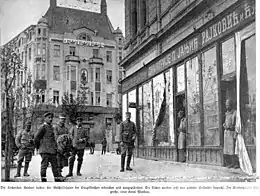 Austro-Hungarian troops in the streets of Belgrade during the occupation of Serbia | |
| Date | 1 January 1916–1 November 1918 (2 years, 10 months, 4 weeks and 1 day) |
|---|---|
| Location | North West Serbia West of the Morava Valley |
Part of a series on the |
|---|
| History of Serbia |
 |
|
|
Austria-Hungary's declaration of war on Serbia on 28 July 1914 marked the beginning of the First World War. After three unsuccessful Austro-Hungarian offensives between August and December 1914, a combined Austro-Hungarian and German offensive breached Serbian territory from the north and west in October 1915 while the Bulgarian army attacked from the south-east. By January 1916, all of Serbia was occupied by the Central Powers.
Serbia was divided into two separate occupation zones, Bulgarian and Austro-Hungarian, both under a military administration, Germany declined to seek territory for themselves but took control instead of railways, mines, forestry, and agricultural resources in both occupied zones. The Austro-Hungarian occupation zone covered the northern three-quarters of Serbia, it was ruled by the Military General Governorate, an administration set up by the Austro-Hungarian Army with a military governor at its head seconded by a civil commissioner. The goal of the new authority was to denationalise the Serb population and turn the country into a territory from which to draw food and exploit its economic resources.
In addition to a severe military legal system, banning all political organizations, forbidding public assembly, and bringing schools under its control, a ruthless system of economic exploitation was instituted. Uprisings were crushed with the harshest measures, including public hanging and shooting. During the occupation between 150,000 and 200,000 men, women, and children were deported to camps, built for that purpose in Austro-Hungarian territories, most notably Mauthausen in Austria, Auschwitz in Austrian Poland, and Györ in Hungary.[1]
The breakthrough of the Salonika front in October 1918 followed by the liberation of Belgrade on 1 November brought to an end the occupation of the country.
Background
After the assassination of the Habsburg heir Franz Ferdinand by a Bosnian Serb student, the prestige of Austria-Hungary necessitated a punishing attack on the state that they deemed responsible. The Austrian military leadership was determined to destroy Serbian independence, which they saw as an unacceptable threat to the future of the empire and its large south Slav population.[2] On 28 July 1914, one month after the murder of the Archduke and his wife, Austria-Hungary declared war on Serbia, Habsburg batteries at Semlin on the Sava River immediately began hostilities by bombarding Belgrade, effectively beginning the First World War. Operations against Serbia were placed in the hands of Feldzeugmeister Oskar Potiorek, Governor-General of Bosnia-Herzegovina, on the morning of 12 August 1914 the first invasion of Serbia began.[3]
The punitive expedition
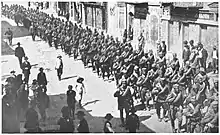
During the first invasion of Serbia, the Strafexpedition[4] (punitive expedition) of August 1914, Austro-Hungarian forces occupied Serbian territories for 13 days. That first occupation turned into a brutal war of annihilation, accompanied by massacres of civilians and the taking of hostages;[5] during that period between 3,500 and 4,000 Serb civilians were killed in executions and random violence by marauding troops.[6]
Mass execution took place in numerous northern Serbia towns. On 17 August 1914, in the Serbian town of Šabac, 120 residents, mostly women, children and old men, who had previously been locked in the church, were shot and buried in the churchyard by Austro-Hungarian troops on the orders of Field Marshal Lieutenant Kasimir von Lütgendorf.[7] These type of attacks did not take place in the turmoil of the battle, but arranged and planned at the highest level.[8] Swiss criminologist pioneer Professor Archibald Reiss reported on the multiple atrocities committed by the Austro-Hungarian Army in a report that was presented at the Paris Peace Conference of 1919.[9]
A second invasion in November captured Belgrade, the conquered territory was divided into five county commands (Etappenbezirkskommando). Austro-Hungarian Croat Field-Marshall Stjepan Sarkotić was appointed Governor-General of the Military Governorate in Belgrade, concentration camps were set up and tens of thousands of Serbs interned.[6] By mid-December the Serbs managed, against all odds, to defeat the invaders at the battle of Kolubara and repel them out of the country by 15 December.[10]
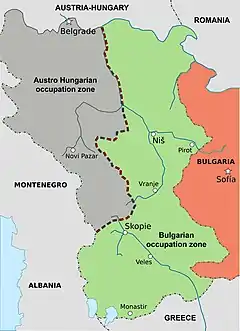
Humiliation at the hands of a small Balkan peasant kingdom badly wounded the pride and prestige of the dual monarchy and its military but although Austria-Hungary had failed to crush Serbia, the Serbs had exhausted their military abilities[11] and had to deal with an epidemic of typhoid fever that further decimated the army and civilian population. Germany urged Austria-Hungary to restore lost prestige by yet another offensive, but without Bulgarian participation in an offensive against Serbia, the Austro-Hungarian commander-in-chief would not consider it until almost a year later.[12]
The campaign of the central powers
In September 1915 a secret agreement and a military convention was signed between the Central Powers and Bulgaria in Plessa. In October Serbia fell to a combined German, Austro-Hungarian, and Bulgarian invasion that followed the offensive of the Central Powers. The massive superiority in numbers and equipment of the invaders, especially in artillery, as well as the failed intervention by British and French troops, meant that the campaign was complete within 6 weeks. The defeated Serbian army did not surrender but retreated across the mountains of Albania and Montenegro into exile with the government, the royal house and hundred of thousands of civilians. The Serb Army spent the rest of the war fighting against Bulgarian and German troops on the Salonika front. Towards the end of 1915, Serbia was divided among the victors who each set up harsh occupational regimes.[13]
Administration and governance
Shortly after the retreat of the Serbian army, the country was divided into three zones. The Austro-Hungarian occupation zone stretched from the region west of the Morava valley to the border of Macedonia as well as Belgrade. Bulgaria gained the whole of Macedonia as well as the areas east of the Morava and Southern Serbia, from the Danube to Kosovo. A German control zone was established in the area east of Velika Morava, Južna Morava in Kosovo and the Vardar valley, the Germans took control of railways, mines, forestry, and agricultural resources.[14]
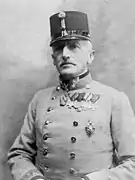
On 1 January 1916 the Austro-Hungarian supreme command ordered the formation of a military governorate, the Military General Governorate of Serbia or MGG/S (Militärgeneralgouvernement in Serbien) was established, with Belgrade as its administrative centre. The Austro-Hungarian occupation zone was divided into thirteen approximately equal districts (German: Kreise) which were then additionally divided into sixty-four boroughs (German: Brezirke), with the city of Belgrade as its own district.[15] The occupation was subordinated to the Austro-Hungarian Armeeoberkommando (Army High Command or AOK), under Franz Conrad von Hoetzendorff and later Arthur Arz von Straußenburg. The Military Governorate of occupation was headed by a General Governor with the rank of a corps commander.[16]
The first Governor-General, Johann Graf Salis-Seewis, a Croat by ethnicity with experience of fighting insurgents in Macedonia, had been commander of the 42nd Honvéd Infantry Division,[lower-alpha 1] an entirely Croatian Division known as Vrazija Divizija or Devil's Division, later found responsible of war crimes during the first Serbian campaign.[17] Salis-Seewis was appointed in late 1915 by the Emperor, officially taking office on 1 January 1916.[15] A civilian commissar in charge with all matters of civilian administration, Dr. Ludwig (Lajos) von Thallóczy, a prominent historian and specialist in Balkan affairs, was appointed by the Hungarian government as his deputy, he arrived in Belgrade on 17 January 1916.[18]
With the Austrians in charge of the military, the administration was mainly formed by Hungarians and Croats. Four administrative departments were set up, military, economic, judicial and political with the latter, which had its own intelligence and police, under future Ustaše leader Major Slavko Kvaternik,[19] while Military Intelligence (Nachrichtenabteilung) was under Croat Composer Ludwig (Lujo) Šafranek-Kavić.[20]
In December 1916, Thallóczy was killed in a train crash while returning to Belgrade from Vienna,[21] in January 1917, Teodor Kušević a high-ranking functionary from Bosnia-Herzegovina was appointed Civilian Commissioner to replace him, his function was given more prominence with new area of responsibility including trade, police, religion, education, justice and the finance department.[15]
System of occupation
The first measure of the occupiers was the inauguration of a new legal system that would prevent guerilla resistance and exploit Serbia's economic resources, for this the Austro-Hungarian control over the population was done in accordance with "Directives for the Political Administration in the Areas of the General Military Governorate in Serbia" (Direktiven für die politische Verwaltung im Bereiche des Militärgeneralgouvernements in Serbien) and "General Principles for the Imperial and Royal Military Administration in the Occupied Territories of Serbia" (Allgemeine Grundzüge für die K.u.K Militärverwaltung in den beset-zen Gebieten Serbiens). MGG/S intended to ignore Hungarian objections and integrate Serbia as a part of the empire, but as an area that would remain under direct military rule for decades after the end of the war and where political participation would be prohibited to prevent the re-emergence of a new Serbian state.[22]
The Austro-Hungarian military had relied on paramilitaries in capacity of irregulars troops during the final phase of the invasion, these troops consisted of Albanian clansmen from Kosovo or northern Albania. Austria and Hungary both supported the repatriation of Muslim refugees in occupied territory in order to weaken Serbia and strengthen the Muslim presence, as in Bosnia, Austria subsidised and actively encouraged Islamic institutions to frustrate South Slav nationalism.[23]
The Austrian authorities allowed Albanian Kosovars to set up local governments and many of them volunteered for service in the Austrian military.[24] Albanian notables offered the occupying authorities to recruit volunteers, Muslim dignitaries in places like Novi Pazar and Mitrovica also declared their support. According to the notes of Colonel Hugo Kerchnawe the Muslims in Sandžak and the Albanians in Kosovo “behaved very loyally and offered their support, while the Serbian Orthodox priesthood were consistently hostile towards the Austrians".[25] Volunteer formations were established, special commissions to organise recruitment were set up by civilian commissar, and renowned albanologist Lajos Thallóczy, assisted by former Ottoman officers, over 8,000 volunteers were recruited this way.[26]
Inter-allied conflicts
Conflict about annexation
The separation of power quickly led to multiple clashes between civilian and military authorities as well as between Austrian and Hungarian authorities. The envoy of the Hungarian foreign ministry in Serbia, Lajos Széchényi, asserted that Salis-Seewis' policies would lead to Serbia's annexation to the dual Monarchy, which Thallóczy, following the Hungarian prime minister's directives, strongly opposed.[18] Thallóczy complained to Tisza in mid-February 1916 about the number of slavs in charge, "the governor is Croat, the chief of the general staff is Czech, the deputy governor is from the former military border and the new General Staff Officer Slavko Kvaternik is the son in law of Croatian independentist Josip Frank".[27]
.jpg.webp)
Conrad von Hötzendorf saw the military administration of Serbia as preliminary to its annexation as a South Slav Union, including Montenegro and Albania, under Croatian leadership,[29] Conrad worried that by not annexing Serbia the monarchy would lose its great power status. Joint Foreign Minister of Austria-Hungary Baron Burian, with Hungarian interests uppermost in his mind, supported the forcible acquisition of Serbia but only if it was to Hungary.[29]
Count Tisza, the Hungarian Prime Minister, would not permit an annexation as it would imply an expansion of the Slavic element, and consequently a significant reduction of the Hungarian part within the dual monarchy, he demanded instead that northern Serbia be colonized with Hungarian and German farmers.[29] After touring the north-western districts of Serbia, together with Salis, and visiting Conrad at Army High Command, Count Tisza was alarmed by what he saw as a confirmation of Austrian's military efforts to make the occupation a prelude to annexation,[21] Tisza submitted a complaint to Foreign Minister Burián asking for a thorough reorganisation of the Military Governorate, the removal of Salis-Seewis and the condemnation of annexationist policy in Serbia; Burian took the complaint straight to the Emperor. By the Emperor's decision of 6 July 1916, Salis-Seewis and his chief of staff, Colonel Gelinek were replaced by his former corps commander, General Adolf Freiherr von Rhemen and Colonel Hugo Kerchnawe on 26 July 1916. Rhemen remained in office until the end of the war.[30]
Tensions in south Serbia
Tensions between Austria and Bulgaria regarding the Albanian-inhabited Serbian territory culminated in March 1916 with a military confrontation when Austrian troops were sent into a number of towns in Kosovo and Albania already garrisoned by Bulgarian troops.[31] The Bulgarians had extended their zone to the western parts of Kosovo and even to Elbasan in Albania a region that Austria-Hungary considered an occupied friend state. Metohija was part of the Austro-Hungarian Military Government of Montenegro, while a smaller part of Kosovo with Mitrovica and Vučitrn was part of the Austro-Hungarian Military Government of Serbia; the greater part of Kosovo, Pristina, Prizren, Gnjilane, Urosevac, Orahovac fell under Bulgarian rule as part of the Military Region of Macedonia.[32]
Conrad warned Bulgarian High Command that unless local Bulgarian commanders abstained from interfering with Austro-Hungarian administration, a conflict with Austro-Hungarian troops seemed inevitable.[33] After Field Marshall Mackensen was sent to mediate between the two allies; an agreement on a demarcation line was signed between the Austro-Hungarian and Bulgarian commands on 1 April 1916, Bulgarians withdrew eastwards, leaving Kosovo to the Austro-Hungarians.[31][34]
Life under the occupation
Denationalisation and depoliticisation of the population

The policies of the Military Governorate of Serbia aimed to depoliticise and denationalise the Serb population since political and national awareness were perceived by the army to be the existential danger to the empire;[35] public assembly and political parties were banned, the Cyrillic alphabet was termed staatsgefährlich (dangerous to the state) and banned from schools and public spaces, streets named after people perceived as significant for national identity were renamed and traditional Serbian clothing was proscribed. The Gregorian calendar replaced the Julian. All Serbian students had to educated in the German language, according to Austrian academic standards and teachers were brought from Austria.[36]
Central national institutions such as the Royal Serbian Academy, the National Museum and the National Library were closed down and looted of their historical artefacts and art collections. The University of Belgrade, publishing houses and bookshops were closed down. Schoolbooks and books in French, English, Russian and Italian were banned. Political expression was severely limited with the prohibition of newspaper publication, except the official organ of propaganda MGG/S's Belgrader Nachrichten (published in Serbian as Beogradske novine), which featured letters and attractive photographs dwelling heavily upon the normality of life in the homeland.[37][lower-alpha 2]
Both Austria-Hungary and Bulgaria publicly announced in 1916 that the Serbian state had been wiped off the political map of Europe. Therefore, since Serbia ceased to exist, the rules of civilized warfare safeguarding the material and spiritual welfare of conquered peoples had been swept aside, its inhabitants could not invoke the international rules of war, such as those defined by the Geneva Conventions.[38]
Repression
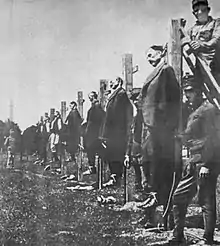
The fear of a levée en masse captured the imagination of the army, causing it to engage in conflict with the population through hostage-taking, reprisals, and summary justice; military law was employed to overcome Serbian national resistance and severe preventive measures were undertaken against civilians. Disarming the populace was done by holding village elders responsible for handing over a certain quota of weapons that were judged to be held before the war began.[39]
There were summary executions at the hands of the Austro-Hungarian authorities with little or no legal process. Military courts even tried Serbians for the crime of lèse-majesté.[40] If civilians were suspected to be engaging in resisting, they would face the harshest measures, including hanging and shooting. The house of the offending Serbian's family would also be destroyed.[41]
The Serbian victims were preferably executed by means of the gallows on the main squares of villages and towns, forcing the population to attend the executions. The lifeless bodies were left to hang by the noose for several days so as to clearly show the treatment reserved to 'spies' and 'traitors' by the Austro-Hungarian army.[42]
Deportation and forced labour
During the occupation between 150,000 and 200,000 men, women, and children were deported to camps. A large portion of Serbian political, intellectual and cultural elite had left the country during the Serbian army's retreat through Albania, the remaining ones, including many university professors, teachers, and priests, especially those who had participated in political, cultural or even sports societies were arrested by the authorities and deported. According to official data from the Red Cross in Austria-Hungary dated 1 February 1918, at the end of 1917 there were 206,500 prisoners of war and internees from Serbia in Austro-Hungarian and German camps. In addition to those dispatched to concentration camps in Hungary, some 30,000 Serb civilians were sent to Austrian camps or used as forced labour.[13]
There were four significant waves of deportation: at the start of the occupation in fall 1915 when Governor-General Salis-Seewis rounded up 70,000 'dissidents', mostly able-bodied men, ex-soldiers, politically suspicious persons, as well as members of the political and cultural elite in internment camps,[43] after Romania entered the war, this period saw the largest-scale deportations, it took place from mid-August to the end of October 1916 after an order to arrest all male aged between seventeen and fifty capable of military service as well as former soldiers was issued, 16,500 people were sent to the camps.;[44] during the Toplica uprising more deportation took place and finally after the breakthrough on the Salonica front in 1918.[45]
Those large scale deportations caused concern around Europe, in April 1917 the Vatican intervened, through the office of the Roman Catholic Church in Austria, against the internment of women and Serbian children between ten and fifteen years old in camps.[46]
Economic exploitation and famine

Austro-Hungarian reports on the state of Serbia in 1915 noted famine threatening the occupation zone and a population in a desperate state after nearly four years of constant war. Late 1915 reports spoke of the necessity of receiving urgent relief to avoid disaster. The return of refugees exacerbated the shortage of food. Harvest yields and produced goods had to be turned over to authorities; food was rationed, Serbia was to become the breadbasket for the army. Tensions between Austrian and German authorities increased after Baron Burián complained that the German military was employing a ruthless system of requisition resulting in famine and pauperisation of the population.[12] The exploitation of mines failed to satisfy the need for vital raw materials because Germany took two-thirds of all production from Serbia as reparations for its military aid.[47]
In this very year (1917) there was a drought that can never be forgotten. A frost and then a drought destroyed everything. Even had there nor been a war, hunger would have invaded us. People ate wild herbs and sawdust made from beechwood . . . . It was then for the first time that we spoke of death.
News of the famine happening in Serbia spread across the world, American, Swiss and Swedish humanitarian organisations offered assistance. According to Red Cross reports, starvation killed more than 8,000 Serbs during the first winter, at the same time figures from the Habsburg High Command reported that 170,000 cattle, 190,000 sheep, and 50,000 pigs had been exported to Austria-Hungary by mid-May 1917.[49]
Resistance
Immediately after the withdrawal of the Serbian army and the introduction of the military government, armed individuals and small groups of insurgents, made of former soldiers who had remained in the country, started to appear with the clear intention of waging a guerrilla campaign against the occupying forces.[50] Komitadjis as the Army frequently called Serb chetniks were deemed outside international law and were to be 'completely wiped out'. In March 1916, General Conrad von Hötzendorf ordered that all resistance be destroyed with ruthless severity.[51]
Town officials and citizens were warned to not give or accept bribes. In Kruševac, the local military commander forbade any bribery, corruption, or defamation of "loyal citizens". Former Prime Minister of Serbia Jovan Avakumović attempted to suggest to Governor-General Johann Graf Salis-Seewis to issue a joint proclamation for the restoration of peace and order. Avakumović's proposal was turned down, and the suggestion that he sign his name next to Salis-Seewis angered the Governor so much that it led to Avakumović's arrest and internment.[52] In order to insist on the character of Serb civilians and Komitadjis as criminals outside the laws and customs of war, the war exhibition of 1917Kriegsausstellung) in Vienna included a special section about guerrilla war in Serbia where visitors could learn about the fighting method used to find Komitadjis and Chetniks including a life-size model of a hideout.[40]
In late September 1916, the Serbian High Command flew in the experienced chetnik guerrilla leader Kosta Milovanović Pećanac from Thessaloniki to organize resistance in Serbia. In February 1917, a large scale uprising broke out in the Toplica District in the Bulgarian occupation zone of Morava, a force of 4,000 armed men and women managed to liberate an area in the Morava valley before the uprising was put down. The Austro-Hungarian military reported from the Summer of 1917 20,000 Serbs dead and the escape of 2,600 into the forests.[53]
Despite the harsh repression, guerilla groups managed to survive and when the Allied offensive started in the Summer of 1918 they proved themselves to be very valuable.[54] Chief of Staff Paul Kirch described after the war the withdrawal of the German 11th Army:
Serb guerilla groups emerged throughout the country and attacked our units when they were resting or eating. They also attacked our rearguard and our supply trains on the march and sabotaged the railways. We have sent special Jäger units against them, but it would have been easier to find a needle in a haystack than to find those guerilla groups in the mountain terrain they are familiar with.[55]
Liberation
With the offensive on the Macedonian front and in particular the success of Entente troops at Dobro Pole, Bulgarian troops could not resist and capitulated on 29 September. New Austro-Hungarian and German troops sent from Ukraine were unable to stop Serbian troops as part of Allied forces advancing north. On 29 October Governor-General von Rhemen and his staff left the country, the next day on 30 October Belgrade was liberated by Serbian troops, after four years of occupation the country was free of foreign presence.[56]
Military commanders and governors

Austro-Hungarian commanders
- Feldzeugmeister Oskar Potiorek (12 August 1914 – 27 December 1914[57])
- Generaloberst Archduke Eugen Ferdinand (27 December 1914 – 27 May 1915[58])
- General Karl Tersztyánszky von Nádas (27 May 1915 – 27 September 1915[59])
- General Hermann Kövess von Kövessháza (27 September 1915 – 1 January 1916[60])
Austro-Hungarian military governors-general
- Feldmarschallleutnant Johann Ulrich Graf von Salis-Seewis (1 January 1916 – July 1916[15])
- Generaloberst Adolf Freiherr von Rhemen zu Barensfeld (6 July 1916 – October 1918[30])
- Feldmarschall Hermann Kövess von Kövessháza (October 1918 – 1 November 1918[61])
See also
- Military General Governorate of Serbia
- Bulgarian occupation of Serbia (World War I)
- Nazi occupation of Serbia (World War II)
Notes
- This division was the only one designated Domobran or home-guard, with the right for officers to use the Croat language instead of German or Hungarian.[17]
- Croat patrols on the front line were to approach Serbian posts and deposit propaganda material such as Belgrader Nachrichten in order to encourage desertion by promising freedom to those longing to return home.[37]
References
Citations
- Luthar 2016, p. 77.
- Lebow 1981, p. 68.
- Schindler 2015, p. 177.
- Merrill 2001, p. 167.
- Jeřábek 1991, p. 25.
- Kramer 2008, p. 140.
- Hastings 2013, p. 226.
- Holzer & Spiegel 2008.
- Levental & Kordić 1992, p. 70.
- Kiraly et al. 1985, p. 569.
- Pavlowitch 2002, p. 122.
- Fried 2014, p. 121.
- Calic & Geyer 2019, p. 166.
- Mitrović 2007, p. 183.
- Mitrović 2007, p. 203.
- Bled 2014.
- Vukcevich 2012, p. 63.
- Buttar 2016, p. 43.
- Jarman 1997, p. 261.
- Gumz 2014, p. 41.
- Höbelt, Otte & Bridge 2010, p. 257.
- Fried 2014, p. 203.
- Fried 2014, p. 169.
- Tatum, D. (2010). Genocide at the Dawn of the Twenty-First Century: Rwanda, Bosnia, Kosovo, and Darfur. Palgrave Macmillan US. p. 4. ISBN 978-0-230-10967-4.
- Suppan 2019, p. 300.
- Rauchensteiner, M.; Kay, A.J.; Güttel-Bellert, A. (2014). The First World War and the End of the Habsburg Monarchy, 1914-1918. V&r Academic. ISBN 978-3-205-79588-9.
- Suppan 2019, p. 299.
- Höbelt, L.; Otte, T.G.; Bridge, F.R. (2010). A Living Anachronism?: European Diplomacy and the Habsburg Monarchy : Festschrift Für Francis Roy Bridge Zum 70. Geburtstag. Böhlau. p. 256. ISBN 978-3-205-78510-1.
- Herwig 2014, p. 161.
- Schweizerische Offiziersgesellschaft 1968, p. 386.
- Glenny 2012, p. 335.
- Glenny 2012, p. 333.
- Afflerbach, H. (2015). The Purpose of the First World War: War Aims and Military Strategies. Schriften des Historischen Kollegs. De Gruyter. p. 129. ISBN 978-3-11-044348-6.
- Mitrović 2007, p. 202.
- Gumz 2014, p. 21.
- Mitrović 2007, p. 232.
- Cornwall 2000, p. 64.
- Laffan 1989, p. 254.
- Mitrović 2007, p. 227.
- De Schaepdrijver 2016, p. 105.
- DiNardo 2015, p. 68.
- Holzer 2014, p. 241.
- Herwig 2014, p. 164.
- Mitrović 2007, p. 228.
- Luthar 2016, p. 76.
- Djordjevic 2015, p. 127.
- Herwig 2014, p. 239.
- Biskupski et al. 2003, p. 44.
- Calic & Geyer 2019, p. 157.
- Tasic 2020, p. 20.
- Mitrović 2007, p. 247.
- Luthar 2016, p. 78.
- Mitrović 2007, p. 261.
- Moal 2008, p. 128.
- Mitrović 2007, p. 316.
- Tasic 2020, p. 22.
- Rauchensteiner, Kay & Güttel-Bellert 2014, p. 176.
- Tucker & Roberts 2005, p. 933.
- Dawnay & Headlam 1933, p. 238.
- DiNardo 2015, p. 47.
- Rauchensteiner, Kay & Güttel-Bellert 2014, p. 987.
Bibliography
- Biskupski, M.B.; Biskupski, M.B.; Biskupski, M.B.; Wandycz, P.S.; University of Rochester press (2003). Ideology, Politics, and Diplomacy in East Central Europe. University of Rochester Press. ISBN 978-1-58046-137-5.
- Bled, J.P. (2014). L'agonie d'une Monarchie, Autriche-Hongrie, 1914–1920. TEXTO (in French). Tallandier. ISBN 979-10-210-0447-4.
- Buttar, P. (2016). Russia's Last Gasp: The Eastern Front 1916–17. Bloomsbury Publishing. ISBN 978-1-4728-1277-3.
- Calic, M.J.; Geyer, D. (2019). A History of Yugoslavia. Central European studies. Purdue University Press. ISBN 978-1-55753-838-3.
- Cornwall, M. (2000). The Undermining of Austria-Hungary: The Battle for Hearts and Minds. Palgrave Macmillan UK. ISBN 978-0-230-28635-1.
- Dawnay, G.P.; Headlam, C.M. (1933). The Army Quarterly. William Clowes & Sons, Limited.
- De Schaepdrijver, S. (2016). Military Occupations in First World War Europe. Taylor & Francis. ISBN 978-1-317-58713-2.
- DiNardo, R.L. (2015). Invasion: The Conquest of Serbia, 1915. War, technology, and history. ABC-CLIO, LLC. ISBN 978-1-4408-0092-4.
- Fried, M. (2014). Austro-Hungarian War Aims in the Balkans during World War I. Palgrave Macmillan UK. ISBN 978-1-137-35901-8.
- Laffan, R.G.D. (1989). The Serbs: The Guardians of the Gate. Armenian Research Center collection. Dorset Press. ISBN 978-0-88029-413-3.
- Glenny, M. (2012). The Balkans: Nationalism, War, and the Great Powers, 1804-2012: New and Updated. House of Anansi Press Incorporated. ISBN 978-1-77089-274-3.
- Gumz, J.E. (2014). The Resurrection and Collapse of Empire in Habsburg Serbia, 1914-1918: Volume 1. Cambridge Military Histories. Cambridge University Press. ISBN 978-1-107-68972-5.
- Hastings, M. (2013). Catastrophe 1914: Europe Goes to War. Vintage. Knopf Doubleday Publishing Group. ISBN 978-0-385-35122-5.
- Herwig, H.H. (2014). The First World War: Germany and Austria-Hungary 1914-1918. Modern Wars. Bloomsbury Publishing. ISBN 978-1-4725-1081-5.
- Höbelt, L.; Otte, T.G.; Bridge, F.R. (2010). A Living Anachronism?: European Diplomacy and the Habsburg Monarchy : Festschrift Für Francis Roy Bridge Zum 70. Geburtstag. Böhlau. ISBN 978-3-205-78510-1.
- Holzer, A. (2014). Das Lächeln der Henker: der unbekannte Krieg gegen die Zivilbevölkerung 1914-1918, mit zahlreichen bisher unveröffentlichten Fotografien (in German). Primus. ISBN 978-3-86312-063-4.
- Jarman, R.L. (1997). Yugoslavia: 1938-1948. Yugoslavia: Political Diaries, 1918–1965. Archive Editions Limited. ISBN 978-1-85207-950-5.
- Jeřábek, R. (1991). Potiorek: General im Schatten von Sarajevo. Eine Publikation des Militärhistorischen Dienstes, Wien / Österreich, Militärhistorischer Dienst: Eine Publikation des Militärhistorischen Dienstes, Wien (in German). Verlag Styria. ISBN 978-3-222-12067-1.
- Kiraly, B.K.; Béla, K.; Király, B.K.; Dreisziger, P.N.; Dreisziger, N.F.; Nofi, A.A.; Kiraly, D.; Kiraly, P.B.; Rockefeller Foundation (1985). East Central European Society in World War I. Atlantic studies on society in change. Social Science Monographs. ISBN 978-0-88033-089-3.
- Kramer, A. (2008). Dynamic of Destruction: Culture and Mass Killing in the First World War. Making of the Modern World. OUP Oxford. ISBN 978-0-19-158011-6.
- Levental, Z.; Kordić, M. (1992). Rodolphe Archibald Reiss: criminaliste et moraliste de la Grande guerre (in French). L'Age d'homme. ISBN 978-2-8251-0197-1.
- Luthar, O. (2016). The Great War and Memory in Central and South-Eastern Europe. Balkan Studies Library. Brill. ISBN 978-90-04-31623-2.
- Merrill, C. (2001). Only the Nails Remain: Scenes from the Balkan Wars. G - Reference, Information and Interdisciplinary Subjects Series. Rowman & Littlefield Publishers, Incorporated. ISBN 978-0-7425-1686-1.
- Mitrović, A. (2007). Serbia's Great War, 1914-1918. Central European studies. Purdue University Press. ISBN 978-1-55753-476-7.
- Moal, F.L. (2008). La Serbie: du martyre à la victoire, 1914-1918. Collection "Les nations dans la Grande Guerre." (in French). 14-18 Éditions. ISBN 978-2-916385-18-1.
- Pavlowitch, S.K. (2002). Serbia: The History Behind the Name. Hurst & Company. ISBN 978-1-85065-477-3.
- Rauchensteiner, M.; Kay, A.J.; Güttel-Bellert, A. (2014). The First World War and the End of the Habsburg Monarchy, 1914-1918. V&r Academic. ISBN 978-3-205-79588-9.
- Reiss, R.A.; Copeland, F.S. (2018). ... Report Upon the Atrocities Committed by the Austro-Hungarian Army During the First Invasion of Serbia. FRANKLIN CLASSICS TRADE Press. ISBN 978-0-344-98444-0.
- Schweizerische Offiziersgesellschaft (1968). Allgemeine schweizerische militärzeitschrift (in German). Huber.
- Schindler, J.R. (2015). Fall of the Double Eagle: The Battle for Galicia and the Demise of Austria-Hungary. Potomac Books. ISBN 978-1-61234-806-3.
- Suppan, A. (2019). National Conflicts, World Wars, Genocides, Expulsions, and Divided Remembrance in East-Central and Southeastern Europe, 1848-2018. Sitzungsberichte (Akademie der Wissenschaften in Wien. Philosophisch-Historische Klasse). Austrian Academy of Sciences. ISBN 978-3-7001-8657-1.
- Tasic, D. (2020). Paramilitarism in the Balkans: Yugoslavia, Bulgaria, and Albania, 1917-1924. The Greater War Series. Oxford University Press. ISBN 978-0-19-885832-4.
- Tucker, S.; Roberts, P.M. (2005). World War I: Encyclopedia. World War I: Encyclopedia. ABC-CLIO. ISBN 978-1-85109-420-2.
- Vukcevich, I. (2012). Croatia: Ludwig von Gaj and the Croats are Herrenvolk Goths Syndrome: Ludwig von Gaj and the Croats are Herrenvolk Goths Syndrome. Xlibris US. ISBN 978-1-4797-6666-6.
- Herwig, H.H. (2014). The First World War: Germany and Austria-Hungary 1914-1918. Modern Wars. Bloomsbury Publishing. ISBN 978-1-4725-1081-5.
- Lebow, R.N. (1981). Between Peace and War: The Nature of International Crisis. A Johns Hopkins paperback. Johns Hopkins University Press. ISBN 978-0-8018-2311-4.
Websites
- Holzer, Anton; Spiegel, Der (2008-10-06). "Geschichte". Erster Weltkrieg (in German).
- Cahoon, Ben (1941-04-17). "Serbia". World Statesmen.org.
Journals
- Djordjevic, D. (2015). "The Austro-Hungarian Occupation Regime in Serbia and Its Break-Down in 1918". Balcanica 2015 Issue 46. Cite journal requires
|journal=(help)